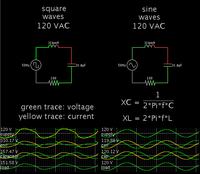Follow along with the video below to see how to install our site as a web app on your home screen.
Note: This feature may not be available in some browsers.

when designing filters you need to know the impedance of the source driving it and the terminating impedance.
Frank
a series RLC circuit behaves as a band pass filter..
if your input is a square wave.... you can decompose it into multiple sine waves using Fourier series
therefore, the RLC circuit is selecting only one particular frequency whose value depends upon center frequency and bandwidth of RLC circuit.
No band pass, only a low pass function for U and I, if we look from sourse to load.yes for voltage that is a low pass filter but for current that is band pass filter.. i think